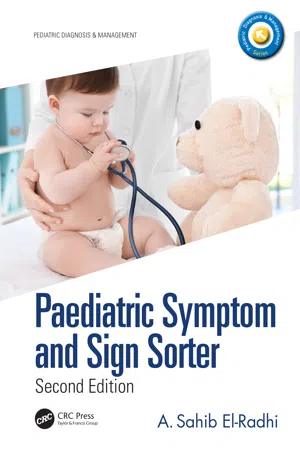
- 240 pages
- English
- ePUB (mobile friendly)
- Available on iOS & Android
About This Book
This book will be a vital tool for all clinicians in the front line when an ill child presents with an acute illness. Experienced paediatricians, postgraduate doctors, primary care physicians, and paediatric nurses will find this a useful refresher, and it will be an invaluable primer for newly trained doctors and students, or those new to the paediatric wards.
Each chapter here provides an overview of each symptom and sign followed by the most likely underlying causes in an easy-to-use tabular format. Investigative techniques and guidelines follow, ranging from the simple and inexpensive to the more complex, as do Top Tips and Red Flag warnings to note; new to this second edition are concluding summaries of Key Points, as well as an entirely new Endocrine chapter.
Frequently asked questions
Information
| Onset in Infants | Children |
| Common | |
| Respiratory distress syndrome | Asthma |
| Transient tachypnoea | Viral-induced wheeze |
| Viral-induced wheeze | Pneumonia |
| Bronchiolitis | CCF |
| CCF | Psychogenic |
| Rare | |
| Pulmonary oedema | Pulmonary oedema |
| Pneumonia | Obstructive airway diseases |
| Pneumothorax | Pulmonary embolism |
| Persistent pulmonary hypertension | Inhaled foreign body |
| Pleural effusion | Chronic lung disease |
| Pulmonary hypoplasia | Neuromuscular disease (e.g. myasthenia gravis) |
| Pericardial tamponade | Hyperventilation |
| Pu... | |
Table of contents
- Cover
- Half Title
- Series Page
- Title Page
- Copyright Page
- Contents
- Introduction
- List of Abbreviations
- Chapter 1: Chest
- Chapter 2: Abdomen
- Chapter 3: Systemic Physical Condition
- Chapter 4: Face
- Chapter 5: Neck
- Chapter 6: Nose
- Chapter 7: Oral
- Chapter 8: Ear
- Chapter 9: Eye
- Chapter 10: Urinary
- Chapter 11: Genital
- Chapter 12: Cerebral
- Chapter 13: Endocrine
- Chapter 14: Skin
- Chapter 15: Hair and Nails
- Chapter 16: Bones and Joints
- Index